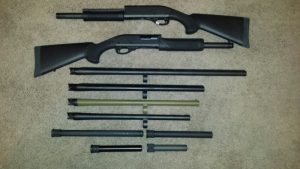Wingshooting: The Battle of Longer vs. Shorter Barrels
When it comes to wingshooting, the barrel length of a shotgun plays a crucial role in determining accuracy, balance, and maneuverability. While longer barrels offer certain advantages, shorter barrels have their own set of benefits. Understanding the pros and cons of both options can help shooters make an informed decision based on their shooting style and preferences. In this article, we will explore the importance of barrel length in wingshooting and delve into the advantages and disadvantages of both longer and shorter barrels.

The Importance of Barrel Length in Wingshooting
The barrel length of a shotgun significantly affects its overall performance in wingshooting. Longer barrels, typically ranging from 28 to 32 inches, offer increased swing and follow-through, resulting in better accuracy. They also provide a longer sighting plane, making it easier for shooters to track moving targets. Moreover, longer barrels contribute to a smoother recoil as the weight distribution is spread out over a larger area. On the other hand, shorter barrels, usually between 26 and 28 inches, offer improved maneuverability, allowing shooters to easily swing through dense cover or navigate tight spaces. The weight reduction in shorter barrels also enhances the shotgun’s balance, making it more comfortable to hold for extended periods.
Pros and Cons of Longer Barrels in Wingshooting
Longer barrels have several advantages in wingshooting. Firstly, the increased swing and follow-through provided by longer barrels allow shooters to maintain their sight picture for a longer duration, resulting in improved accuracy. Additionally, longer barrels offer a longer sighting plane, resulting in better target tracking. This is especially beneficial for those engaging in long-range wingshooting. Furthermore, the weight distribution in longer barrels reduces felt recoil, making it easier for shooters to maintain control and accuracy. However, longer barrels can be cumbersome in tight spaces or when navigating through dense cover. They also tend to be heavier, which may lead to fatigue during prolonged shooting sessions.

The Advantages and Disadvantages of Shorter Barrels in Wingshooting
Shorter barrels offer their own set of advantages in wingshooting. One notable benefit is improved maneuverability. The reduced length allows shooters to easily swing the shotgun through dense cover or swiftly change direction when tracking fast-moving targets. Additionally, the lighter weight of shorter barrels enhances balance, reducing the strain on the shooter’s arms during extended shooting sessions. However, shorter barrels provide a shorter sighting plane, which can make it challenging to track targets effectively, especially over longer distances. The reduced swing and follow-through may also impact accuracy for some shooters, particularly at longer ranges.
In the world of wingshooting, the choice between longer and shorter barrels ultimately depends on personal preference and shooting style. Longer barrels offer increased accuracy, a longer sighting plane, and reduced recoil, but can be less maneuverable and heavier. On the other hand, shorter barrels provide improved maneuverability and balance, but may sacrifice some accuracy and target tracking capabilities. It is essential for shooters to consider their specific needs, shooting environment, and target distances to determine whether longer or shorter barrels will best suit their wingshooting endeavors. Ultimately, practice and familiarity with the chosen barrel length will help shooters maximize their success in the field.
# # #


Comments